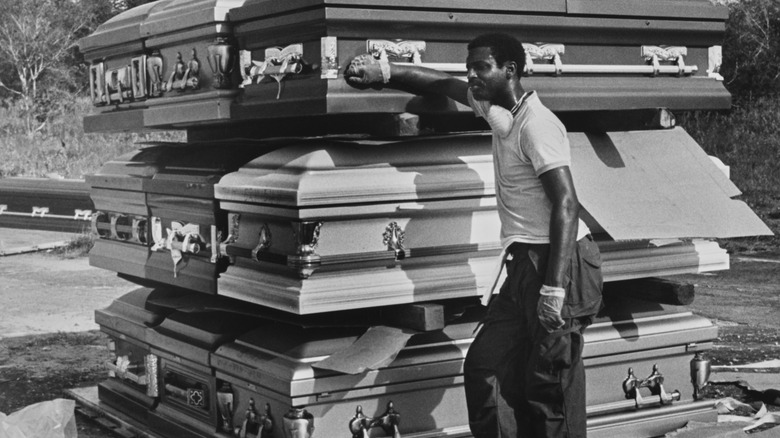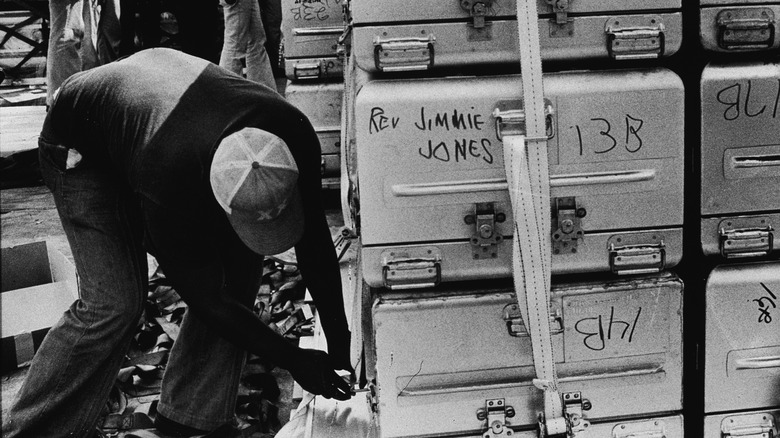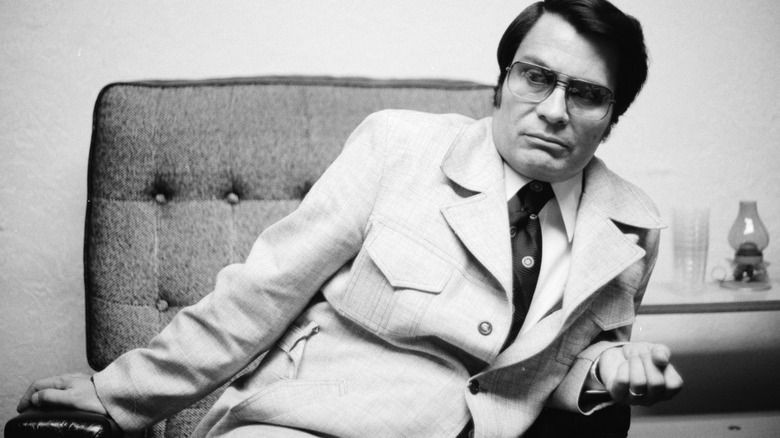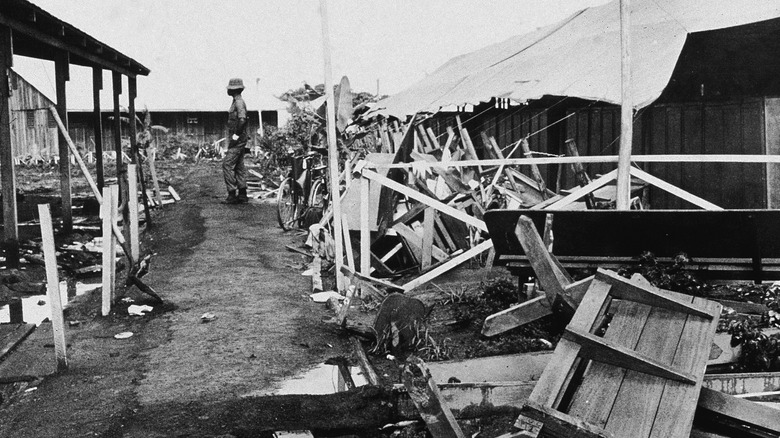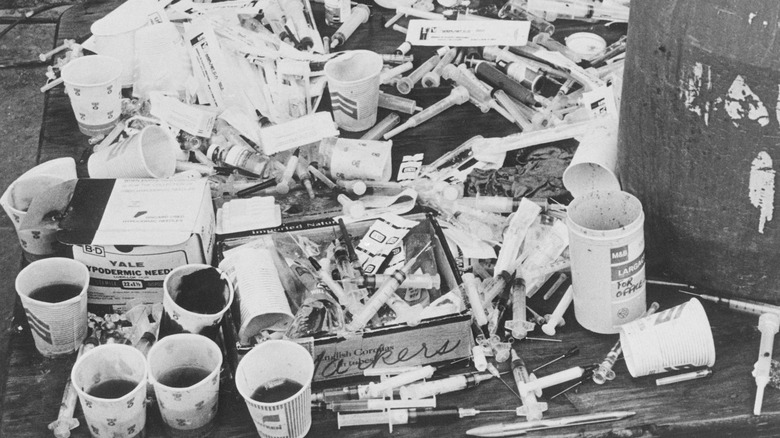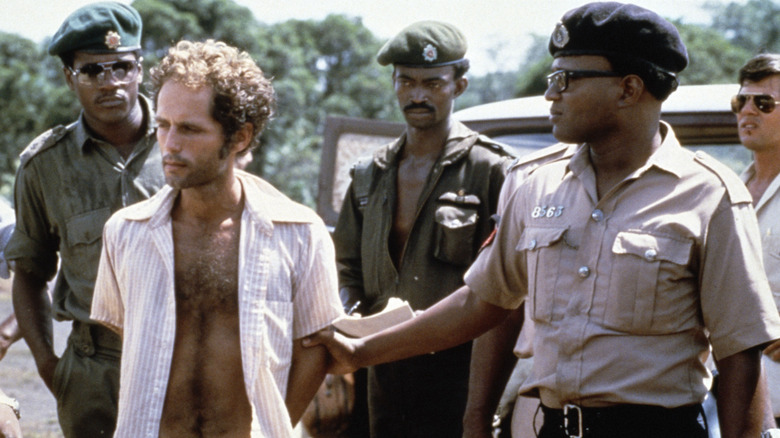Disturbing Things Recovered After The Jonestown Massacre
Jonestown was intended as a sanctuary, an escape from persecution and enslavement. That was how Jim Jones sold it to his flock. He'd started his church in Indiana in 1954, and by 1965 moved his People's Temple to California where he claimed there would be safety from his prophesied nuclear war, and he declared himself God's prophet. His delusions continued to grow, and in 1974 he began developing an area in Guyana to move his congregation to.
According to Biography, the land was to be transformed into a utopian progressive community. Conveniently for Jones, it also provided an escape from California just as the media began to report on the grievances of defectors from the People's Temple, who had stories to tell of coercion, control, and the growing paranoia, drug use, and sexual abuses of Jones himself.
Life in the jungle did nothing to ease Jones's paranoia. The thousand-some followers who went with him to Jonestown were subjected to psychological conditioning through abuse, blackmail, and humiliation, lest they plot against their leader. Jones conducted regular suicide drills and threatened to follow through with a true mass suicide if the Guyanese government didn't leave him be. A visit from concerned congressman Leo J. Ryan in 1978 was the last straw.
The Jonestown massacre, as it has since become known, was the largest orchestrated mass death of American citizens before the September 11 terrorist attacks (per Time). More than 900 people died that day, including Jones, and the recovery efforts left responders traumatized by what they saw — the bodies, the evidence of suicide/murder, and the remnants of the lives lost.
The bodies were already decaying by the time recovery crews arrived
Several days passed between the November 18, 1978, Jonestown massacre and the arrival of first responders to identify and recover the bodies. The commune, located as it was in the Guyanese jungle, meant the corpses of those who died were completely exposed to the hot, humid climate. They were untouched by scavengers; some have speculated that animals such as buzzards, which might have been expected to feed on the bodies, might have stayed away due to the poisons used to kill Jim Jones's followers. But there was nothing to arrest the process of decay.
As a result, when U.S. military personnel arrived at Jonestown to recover the bodies, they were greeted by over 900 people who were already decomposing. Technical sergeant Wayne Dalton noted in a report (via Military Response to Jonestown) that nearly everyone involved in the recovery effort needed to wear a mask just to stand the smell. When there weren't enough masks to go around, some improvised them out of bedding. The stench of the rotting corpses became the most enduring memory of the operation for civilian worker Patricia Edwards, who told Time that it was impossible to forget even decades later.
Drugs used by Jim Jones to control his followers were recovered
That Jim Jones abused drugs himself, notably amphetamines and sleeping pills, is now fairly well-known. By the end of his life, he was addicted. He used the prescriptions of his followers to get his fix or else had People's Temple members who worked as nurses smuggle him some drugs. All the while, he prohibited his congregation from recreational drug use. Jones's son Stephan told A&E that, among the Jonestown population, he believed only his father and the commune's physician indulged in personal drug use.
But after the Jonestown massacre, a massive stockpile of dangerous drugs was recovered from the commune's warehouse. The pharmaceutical hoard had a disturbing list of possible side effects for an isolated and manipulated population: depression, hallucination, impaired cognitive function, and more. The New York Times took special note in its report of the 11,000 doses of Thorazine on the site. And there were no records to provide clues as to who was getting these drugs and at what dosage.
But investigators already knew by the time the drugs were recovered that Jones had used them to sedate and control Jonestown members who tried to leave. Even so, they were stunned at the size of the illicit drug stash, which was grossly out of proportion to their suspected use. Stephan Jones estimated that no more than 15 people were sedated by drugs in Jonestown before the massacre.
Disturbing and suspicious farewell messages were left behind
Perhaps the most haunting and disturbing record of the Jonestown massacre is the so-called "death tape," a recording of Jim Jones's final words to his congregation as they all died around him. A copy of the tape was obtained, transcribed, and published by The New York Times not long after the massacre, and the whole recording has since made its way to YouTube. It lays bare the manipulative tactics of Jones, the efforts of a few People's Temple members to resist death, and the terrible experience of death by cyanide.
The tapes may have been intended to be found, to serve as a record of what Jones called "an act of revolutionary suicide protesting the conditions of an inhumane world." But against the horrors of that tape, there were almost no personal farewells from Jones's victims. According to Rolling Stone, only two goodbye letters were recovered. One was attributed to commune teacher Richard Tropp. In that final message, he falsely absolved Jones of blame for the murder of Congressman Leo J. Ryan and tried to paint the death of nearly a thousand people in as idyllic a light as possible (via Alternative Considerations of Jonestown & People's Temple).
Not everyone who survived the Jonestown massacre, however, is convinced Tropp wrote that letter. One of the survivors, Tim Carter, told Rolling Stone that he personally saw Tropp arguing against Jones's planned suicide up until the last minute. It was well written," he said of the letter, but "[i]t does not jive with the Dick that I saw around 5 o'clock in the afternoon or whatever that time was."
There was evidence that Jonestown was a mass murder, not a mass suicide
As early as December 1978, investigators into the Jonestown massacre pushed back against the idea that it represented a mass suicide. Guyanese authorities told The New York Times that they estimated that only 200 of the 911 victims willingly took the cyanide-laced Flavor Aid that killed them. Survivors have often described Jonestown as a mass murder rather than a suicide. Jim Jones had repeatedly subjected his followers to drills of mass suicide that were later passed off as loyalty tests. On the fateful day, armed guards surrounded the congregation and prevented escape. And the children of Jonestown, who couldn't have known or consented to what they were doing, were the first killed.
Nevertheless, at least one survivor, Odell Rhodes, told authorities that most people initially took the cyanide willingly (per The Washington Post). It was only when people started to die that those still living were forced to drink at gunpoint. But during the recovery process, several bodies were found with injection marks. Along with the syringes found at the scene (pictured), it suggests that at least some Jonestown victims were stuck with needles full of the poison rather than willingly drinking it.
There were only a handful of survivors
Out of the nearly 1,000 people Jim Jones brought to Jonestown, only 85 survived the massacre (per The New York Times). Some, like Jim Jones's son Stephan, survived by dint of not being on the scene; they were in Georgetown, competing in a basketball game. Others, like Larry Layton (pictured), were away on Jones's business of murdering Congressman Leo J. Ryan's delegation. Per the FBI, Layton would become the only person tried and convicted for the Jonestown massacres.
But there were some who were there in Jonestown when the murder-suicide took place who managed to escape with their lives. A small handful simply ran for it, including Leslie Wagner-Wilson and her son. "I was so scared I was shaking," she recounted for the New Zealand Herald, adding that she expected to be shot dead at 22 for deserting the commune. Jones sent three men to the Soviet embassy in Guyana with millions in cash and gold, inadvertently sparing their lives. Catherine "Hyacinth" Thrash hid under her bed, and Grover Cleveland Davis slept through it (per IndyStar). They came out of their huts to find everyone dead or fled.
